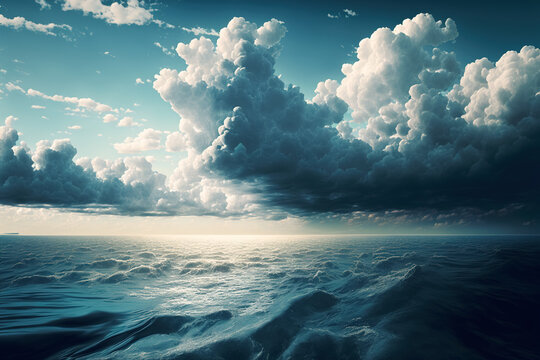By A’liya Spinner
Discovery and conservation of the world’s greatest resource
Under the Sea
Maria silenced the engines, slowing the Tortuga to a silent drift. Around her were dark screens that showed her a live feed of their lightless surroundings, but the LiDAR proximity sensors had indicated they’d reached just a meter above the seabed, and mapped a flat, ancient trench floor all around the submersible.
“Lights up,” Maria said.
“Yes, captain,” her sole companion, Simon, answered as he adjusted a series of dials. Maria rolled her eyes— the two of them were close friends and had completed many missions together in Tortuga, but despite her telling him it was unnecessary, he always referred to her by her title. She guessed it made their high-tech, cramped submarine voyages feel more like the great oceanic expeditions of centuries ago.
The screens lit up around Maria as the flood lights came on. Slowly, the giant beams rotated around the Tortuga, illuminating a barren seabed of pale sand. A small snailfish, white as bone, drifted past as it searched for something to eat. It did not even seem to notice the submarine— most of the animals down here didn’t have functional eyes to be bothered by the flood lights, and the Tortuga had new state-of-the-art electric engines that made no noise and minimal ripples in the water. It was the least invasive exploratory vessel to date, and Maria was proud to captain it.
“We’re picking up something on the LiDAR,” Simon reported. He expanded a readout on one of his own screens, showing a recreation of the seafloor with a mysterious, instinct blob a few meters off the starboard side.
“Let’s check it out.” Maria tilted the Tortuga towards the object and then slowly nudged them forward. Through the screens, she watched the landscape of blank sand roll past, tilting the ship’s brilliant beam to zero in on Simon’s obstacle. Her heart sank as the light revealed a crumpled plastic bag in the silt, half-buried, eerie and unnatural in the seemingly pristine ecosystem of the isolated trench.
“More garbage. Deploying the gripper.” Maria took hold of a controller as Simon made a disappointed groan. This was not the first sign of human contamination they’d discovered in the abyss, and it would likely not be the last. But the Tortuga came equipped for this situation; with trained precision, Maria extended a long arm from the bottom of the submarine and used the mechanical “hand” at its end to grab the bag and pull it from the dirt. Dust flew up into the water in a murky cloud as the gripper pulled the plastic waste back into the belly of the Tortuga for proper disposal at the surface.
“Hey, Captain.” Simon twisted a dial to adjust the frequency of the LiDAR pulses, just as Maria had finished redocking the gripper arm. “Something just came into range.” He forwarded
the angle to her controls, and she tilted the Tortuga again. The seabed rolled past, slowly, as not to disturb more silt or the sensitive wildlife.
Then, a flash of movement— something larger than a snailfish, just on the edge of vision. Simon’s scanners beeped, and Maria hurried to rotate the flood lights, catching the anomaly in a brilliant white beam.
It was like nothing she had ever seen, so translucent that the individual bones of its spine and primitive fins almost seemed to glow in the light. Green bioluminescence trailed down its eel-like body as it undulated through the water, twisting a head several times wider than its body and jaws long enough to swallow a snailfish whole. It did not notice the Tortuga, flexing its unbelievably massive mouth, searching for prey.
“What is that?” Simon asked, adjusting the on-board cameras to take a series of pictures of the abyssal fish. Maria grinned and shook her head, assuming the controls to follow the creature as it started to vanish again into the darkness.
“Let’s go find out.”
The Worlds Oceans
Although we often divide them into smaller bodies, the oceans of the world are more accurately visualized as a singular, interconnected organism, covering 71% of the Earth’s surface and containing 332,519,000 cubic miles of water. Similar to cargo and cruise ships that sail around the globe, oceanic currents and marine species (whales, sharks, salmon, and many others) travel between the interconnected seas and visit the shores of different continents.
Oceanography— exploration and study of the ocean through a combination of geology, biology, chemistry, physics, and engineering— is a relatively new field of science, beginning in earnest after World War II as submarines entered the world stage. What started as simple mapping of the seafloor became campaigns of core and sediment collection, remotely-operated expeditions to some of the deepest trenches in the world, and global satellite imaging of currents. As of today, we have explored only five percent of the world’s oceans, and are making new discoveries at an unbelievable rate; hundreds of new species are discovered in the ocean every year, and scientists estimate there may be upward of two million more to find. Many of these organisms— along with yet unstudied marine and geographical phenomena— are likely to be found in either the dark, deep abysses, or in colorful, shallow coral reefs, both of which face unique pressures from pollution and climate change. Therefore, our discovery of the oceans is intrinsically linked to our conservation of its ecosystems and equilibrium.
Discovery
As our technology advances and diversifies, so do the opportunities for discovery in the formidable ocean. Crushing depths, freezing temperatures, and lightless caverns once prevented human exploration, but now developments in automation and manned submersibles have unlocked even the most treacherous destinations for study.
Perhaps the most famously inaccessible destination— Challenger Deep, the lowest part of the Mariana Trench and the deepest abyss that we know of today— is one such location that has recently seen a boom in exploration. Until 2019, only three people had ever been to its bottom: Jacques Piccard and Navy Lt. Don Walsh, who proved to the world that life could exist at extreme depths, and James Cameron, who completed the first solo “dive” into the trench. Then came the advent of the DSV Limiting Factor, a two-person submarine capable of making repeat, sustained journeys to the bottom of Challenger Deep. Since its deployment, the Limiting Factor has made the trip nineteen times, as well as becoming the first manned vessel to reach Brownson Deep, the deepest point of the Atlantic Ocean. Already, these voyages have discovered species formerly unknown to science, including new species of snailfish and bizarre life forms that resemble nothing else yet described. And this is only the beginning; the high-pressure, lightless ecosystems that exist at the bottoms of the Earth’s trenches are as unique as they are isolated, and promise decades more of fruitful exploration. Particularly, microbes clustered around deep-sea chemical vents and samples from the world’s oldest seafloor may provide clues as to the origin of life on Earth, acting as a nearly-pristine window into the extreme conditions present when the planet’s first microorganisms were formed.
Another important tool used in oceanography is LiDAR: Light Detection and Ranging. Marine LiDAR uses pulses of water-penetrating green light to generate a topographic map of the ocean floor. Accurate and easy-to-acquire bathymetric data is necessary for charting safe naval routes, but it also plays an important role in monitoring climate change. LiDAR surveys of coastlines and coral reefs track changes caused by erosion and global rising temperatures, and can even predict floods by monitoring currents and salinity. Marine biologists employ LiDAR to study the habitats of benthic (bottom-dwelling) or rare organisms without disturbing their oftentimes endangered ecosystems with bulky submersible equipment. It has even been used by archeologists to discover a 7,000-year-old prehistoric site off the coast of Australia, a particularly exciting development given the difficulty of locating submerged artifacts.
Finally, exploration without human passengers is being used to look inside environments formerly too small or inhospitable for manned expeditions. For example, an ROV (Remotely Operated Vehicle) is currently being outfitted to withstand a voyage into the Canada Basin, an isolated and almost entirely human-inaccessible area of the Arctic Ocean, shielded by depth and ice. Oceanographers believe the Basin, having been geographically isolated for millions of years, may contain “relic” life forms from the Earth’s distant past, as well as yet-undiscovered organisms. NOAA (the National Oceanic and Atmospheric Administration) also hopes to find evidence of “slope failure”, which is linked to the melting of the Arctic and emission of greenhouse gasses, as well as changing currents under the ice. The Beaufort Gyre— a powerful, freshwater current driven in part by the Canada Basin and which has impacts on the circulation of global water— has grown nearly 40% in size since 2000, and is now able to be studied like never before through the use of durable, ice-faring ROVs.
The Threatened Ocean
New discoveries on our planet are intrinsically linked to its preservation, especially in the face of climate change. Study of the ocean currents increasingly reveals the dangers of melting ice caps; massive influxes of polar freshwater can severely slow and or even halt the global currents, which would have devastating effects on the climate. In fact, loss of the oceanic currents (the “green belt” that cycles water between the equator and poles) would make substantial swaths of the Earth’s land uninhabitable as equatorial temperatures rise and polar temperatures plummet. Loss of the ice caps has a much more immediate threat, as well: the rising sea level. Man-made climate change has been causing the seas to rise at an unprecedented rate, leading to increased erosion of coastal communities and habitats. People, plants, and animals living along the coast are also at an increased greater risk of floods, hurricanes, and other water-related disasters due to instability in the climate.
Biodiversity is also endangered by human activity and man-made change on a global scale. Ocean acidification— a shift in the pH of water caused by rising temperatures— is the primary cause for the mass depletion of coral reefs, which contain twenty-five percent of the ocean’s species and process millions of tons of carbon dioxide every year. Similar habitat degradation caused by pollution and overfishing poses a threat to animals that live on the open seas, from small crustaceans to giant whales, which in turn impact all other species in the food web. Even the very depths aren’t free from human contamination— plastic was found by the Limiting Factor at the bottom of Challenger Deep, as well as several other abyssal trenches.
But while it may seem dire, public awareness and motivation for combating the decline of the marine ecosystem has never been higher, and not only are we discovering new species, but new methods of preserving them, as well.
Conservation
Physical garbage— typically plastic that amasses from all around the world, swept out to sea from waterways, landfills, and factories— does not decompose, and contaminates ecosystems. A massive gyre known as the “Great Pacific Garbage Patch” is perhaps the most well-known instance of trash accumulation, but contrary to popular belief, it is not made up of a congealed plastic island. Rather, nearly 70% of plastic waste sinks to the ocean floor, leaving a visible cloud of microplastics that drift in the currents. Like single-use plastic debris, microplastics can cause internal injury to organisms that consume them— but we now have more tools than ever available for combatting these pollutants. The Ocean Cleanup project uses computational models to predict the movement of these contaminated gyres, and identify areas in need of the most aid; specialized nets pulled by teams of electrically-powered boats can be dragged slowly through the water, gathering debris without trapping marine animals. Ocean Cleanup optimistically predicts that their full deployment of ships, nets, and waste-reduction programs at many common sources of marine pollution can reduce free-floating plastic waste by 90% by the year 2040. Their goal is helped by SeaClear, designers of a cooperative pair of AOVs (Autonomously Operated Vehicle) intended to find and collect trash from the seabed. One machine is able to locate artificial wash (using sensors and algorithm to discern it from marine animals or natural structures), while the other uses suction and gripping devices to remove target garbage. Autonomous vehicles such as these are currently underutilized in clean-up efforts, but will soon enable more thorough and precise operations in hazardous areas (such as the trenches or sea caves), or ecosystems easily disturbed by massive nets and human-operated missions, like the coral reefs.
The future of research is also dependent on development in the field of small, robotic assistants, whether they be remotely or autonomously operated. Small, oceanic machines do not need the size or safety resources to accommodate human passengers, making them not only cheaper to build, cleaner to power and operate, but also significantly less invasive in unfamiliar ecosystems. Especially, smaller, remotely-managed expeditions help reduce the barrage of underwater noise caused by ship traffic in the breeding and feeding grounds of cetaceans and mollusks, which has been proven to agitate or disorient these already threatened animals.
The Earth’s oceans are an interconnected, living organism, and they are changing. Some of these changes cannot be easily reverted, but there is still much hope for the future. The melting ice sheets provide a rare and invaluable opportunity to study undiscovered ecosystems, and protect them under international law. The same is true for the dark, alien environments at the bottom of the trenches, unexplored but already contaminated by human garbage. With growing global consciousness about climate change and autonomous or non-invasive new methods for oceanic clean-up, we have the chance to preserve and repair the pristine beauty of marine diversity. And, while oceanic gyres and global currents may seem beyond our ability to change, understanding the most endangered parts of the ocean, how acidification and rising temperatures affect the seas, and where to concentrate our rescue efforts allows for not only the maintenance of these pressure points, but the continuous, long-term commitment to protecting and healing our great water world.





